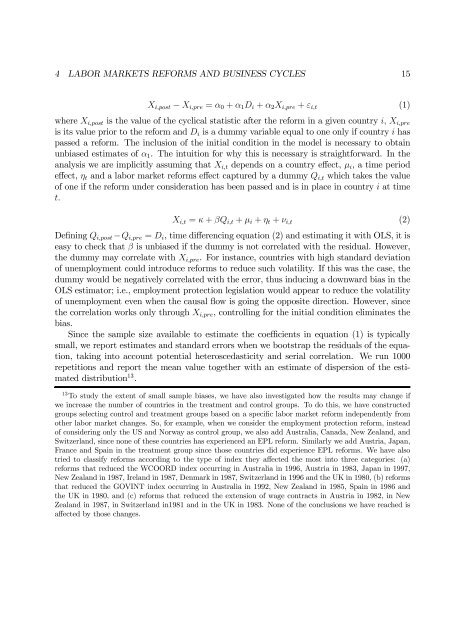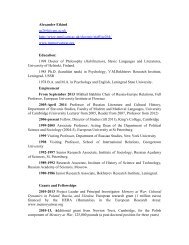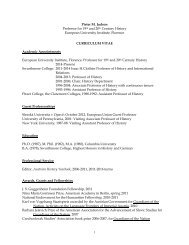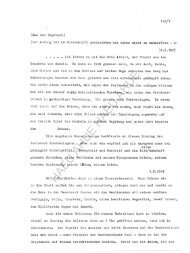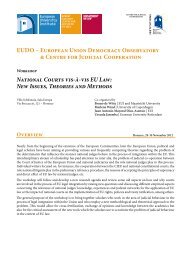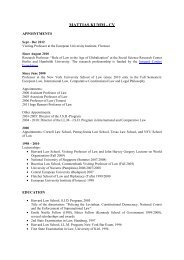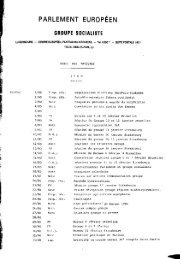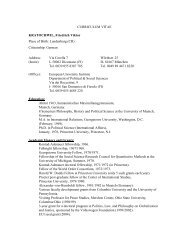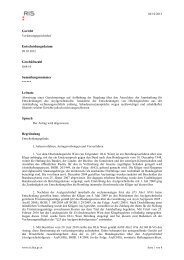Do labor market institutions matter for business cycles?∗ - European ...
Do labor market institutions matter for business cycles?∗ - European ...
Do labor market institutions matter for business cycles?∗ - European ...
Create successful ePaper yourself
Turn your PDF publications into a flip-book with our unique Google optimized e-Paper software.
4 LABOR MARKETS REFORMS AND BUSINESS CYCLES 15<br />
X i,post − X i,pre = α 0 + α 1 D i + α 2 X i,pre + ε i,t (1)<br />
where X i,post is the value of the cyclical statistic after the re<strong>for</strong>m in a given country i, X i,pre<br />
is its value prior to the re<strong>for</strong>m and D i is a dummy variable equal to one only if country i has<br />
passed a re<strong>for</strong>m. The inclusion of the initial condition in the model is necessary to obtain<br />
unbiased estimates of α 1 . The intuition <strong>for</strong> why this is necessary is straight<strong>for</strong>ward. In the<br />
analysis we are implicitly assuming that X i,t depends on a country effect, µ i , a time period<br />
effect, η t and a <strong>labor</strong> <strong>market</strong> re<strong>for</strong>ms effect captured by a dummy Q i,t which takes the value<br />
of one if the re<strong>for</strong>m under consideration has been passed and is in place in country i at time<br />
t.<br />
X i,t = κ + βQ i,t + µ i + η t + ν i,t (2)<br />
Defining Q i,post −Q i,pre = D i , time differencing equation (2) and estimating it with OLS, it is<br />
easy to check that β is unbiased if the dummy is not correlated with the residual. However,<br />
the dummy may correlate with X i,pre . For instance, countries with high standard deviation<br />
of unemployment could introduce re<strong>for</strong>ms to reduce such volatility. If this was the case, the<br />
dummy would be negatively correlated with the error, thus inducing a downward bias in the<br />
OLS estimator; i.e., employment protection legislation would appear to reduce the volatility<br />
of unemployment even when the causal flow is going the opposite direction. However, since<br />
the correlation works only through X i,pre , controlling <strong>for</strong> the initial condition eliminates the<br />
bias.<br />
Since the sample size available to estimate the coefficients in equation (1) is typically<br />
small, we report estimates and standard errors when we bootstrap the residuals of the equation,<br />
taking into account potential heteroscedasticity and serial correlation. We run 1000<br />
repetitions and report the mean value together with an estimate of dispersion of the estimated<br />
distribution 13 .<br />
13 To study the extent of small sample biases, we have also investigated how the results may change if<br />
we increase the number of countries in the treatment and control groups. To do this, we have constructed<br />
groups selecting control and treatment groups based on a specific <strong>labor</strong> <strong>market</strong> re<strong>for</strong>m independently from<br />
other <strong>labor</strong> <strong>market</strong> changes. So, <strong>for</strong> example, when we consider the employment protection re<strong>for</strong>m, instead<br />
of considering only the US and Norway as control group, we also add Australia, Canada, New Zealand, and<br />
Switzerland, since none of these countries has experienced an EPL re<strong>for</strong>m. Similarly we add Austria, Japan,<br />
France and Spain in the treatment group since those countries did experience EPL re<strong>for</strong>ms. We have also<br />
tried to classify re<strong>for</strong>ms according to the type of index they affected the most into three categories: (a)<br />
re<strong>for</strong>ms that reduced the WCOORD index occurring in Australia in 1996, Austria in 1983, Japan in 1997,<br />
New Zealand in 1987, Ireland in 1987, Denmark in 1987, Switzerland in 1996 and the UK in 1980, (b) re<strong>for</strong>ms<br />
that reduced the GOVINT index occurring in Australia in 1992, New Zealand in 1985, Spain in 1986 and<br />
the UK in 1980, and (c) re<strong>for</strong>ms that reduced the extension of wage contracts in Austria in 1982, in New<br />
Zealand in 1987, in Switzerland in1981 and in the UK in 1983. None of the conclusions we have reached is<br />
affected by those changes.


